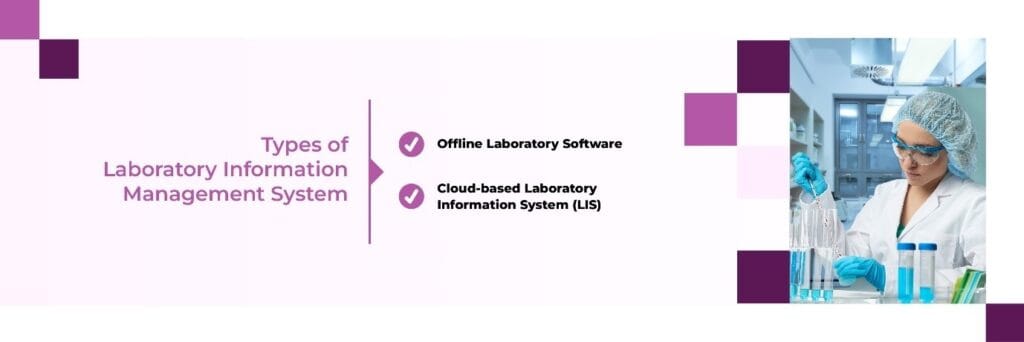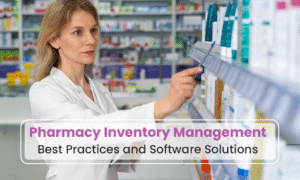
Contents
- What is a Laboratory Information Management System?
- What are the advantages of a Laboratory Information Management System?
- What are The Types of Laboratory Information Management Systems
- Why is a Laboratory Information Management System Important?
- What Are The Components of a Laboratory Management System?
- Top 5 Laboratory Information Management System?
- Guide to Choosing the Right Laboratory Information Management System for Your Needs
- How does Lab Information Management Software Meet the Modern Needs of Labs today?
- What are the best features of the laboratory information system?
- What is The Future of LIMS Software? The Scope of Laboratory Information Management System.
- Conclusion
What is a Laboratory Information Management System?
A Laboratory Information Management System (LIMS) is utilized for the oversight of laboratory procedures and data. It holds the potential to enhance efficiency and maintain quality control within the laboratory environment through its capabilities for monitoring progress, streamlining workflows, and enforcing standardized operational procedures.
The Laboratory Information Management System automates all clinical pathology lab operations, encompassing patient registration, appointment scheduling, order management, billing, sample handling, data management, and department-specific pathology tests. This system enhances efficiency, ensures compliance, and facilitates comprehensive reporting.
The concept of LIMS is dynamic and continuously evolving, with regular additions of novel features and capabilities. As laboratory requirements shift and technological advancements unfold, the role of a LIMS is also expected to transform. Despite these shifts, a foundational set of functions remains integral to a LIMS.
These functions can be broadly categorized into below mentioned phases of laboratory processing, each encompassing various software tasks:
- Receive and manage lab orders from primary or secondary care professionals.
- Receiving and logging in samples along with relevant customer data.
- Assigning, scheduling, and monitoring samples and their associated analytical workloads.
- Managing processing, including quality control, equipment utilization, and inventory.
- Storing data linked to sample analyses.
- Reviewing, approving, and organizing sample data for reporting or further analysis.
- Manage in-house or outsource lab tests
- Manage purchase and consumption of lab inventory
- Prepare and approve lab reports along with the despatch and patient interactions.
- Compliance management in line with NABL.
What are the advantages of a Laboratory Information Management System?

Laboratory Information Management Systems (LIMS) has a wide range of advantages in the management of extensive laboratory data and the maintenance of rigorous guidelines. This leads to enhanced effectiveness and quicker processing intervals, allowing for automation and beyond. The main difference that distinguishes LIMS systems significantly is their array of configuration tools, meticulously crafted to facilitate the creation of streamlined, exceptionally flexible workflows.
Furthermore, LIMS serves as a facilitator of regulatory compliance by furnishing a comprehensive audit trail encompassing all data and activities linked to a sample or test unit.
The Key Advantages of Laboratory Information Management System are as Follows:
- LIMS establishes a centralized database for the storage and retrieval of information pertaining to samples, lab tests, and outcomes.
- LIMS empowers laboratories to share data and resources seamlessly across various departments or facilities.
- The system contributes to heightened efficiency, accuracy, and quality control in the laboratory by offering tools for managing lab tasks, monitoring advancement, orchestrating workflows, and scrutinizing data.
- LIMS also aids in cost reduction by automating manual tasks.
What are The Types of Laboratory Information Management Systems

There are two primary types of LIMS systems: Offline and Cloud-based LIMS.
Offline or Standalone Laboratory Software
Offline and standalone laboratory software refers to the practice of installing purchased LIMS software within your own IT infrastructure, located behind a firewall. This implementation approach involves ongoing expenses for maintaining on-premises hardware and performing necessary updates. Choosing this method of integrating your LIMS software into your IT setup could offer a greater sense of security.
Initial expenses for software licenses, implementation, and training are typically paid upfront. It’s important to also consider subsequent costs like services and upgrades after the initial implementation.
However, there are drawbacks to adopting on-premises LIMS software. The ongoing costs related to management and maintenance are likely to be significantly higher compared to Software as a Service (SaaS). Additionally, there might be challenges associated with the need for a dedicated healthcare IT service and support team to manage the system effectively.
Cloud-based Laboratory Information System (LIS)
In comparison to the first one, the cloud-based option is notably more sophisticated and adaptable. It provides extensive storage capacity and accommodates scalability with flexibility. Therefore, if your lab is in the process of expansion in a single location or multiple locations, concerns related to data flow and operational management are effectively addressed by cloud-based Lab information management software. This is why cloud-based LIMS stands out as a superior choice compared to standalone lab software.
If you are still confused regarding the offline and SaaS software for your labs, check out our blog Know the comparison between SaaS and on-premise services in healthcare IT solutions. – Ezovion
Why is a laboratory Information Management System Important?
Laboratory information management system (LIMS) plays a crucial role in enhancing the operational efficiency of healthcare laboratories by optimizing workflows and replacing manual information upkeep.
Its origins lie in recording samples, their outcomes, and relevant patient details. From its inception to becoming a full-fledged laboratory management system, it initially adhered to traditional practices of labelling and record retention. Gradually, a dedicated laboratory information management system emerged, introducing innovative functionalities.
In the present day, this software stands as highly dependable. Upon sample collection, it is transported to the laboratory for tagging. The software suite is capable of continuously updating the progress and database results in real time. Overall, it facilitates the efficient collection of samples and timely delivery of reports to patients. Serving as an interface between the database and laboratory staff, it stores essential data, effectively bridging the gap between the two.
An ideal LIMS excels in overseeing record-keeping and the creation of reports. Among the primary functions of a LIMS are sample and inventory management, test administration, and reporting.
Some of the primary functions of laboratory information management system are as follows-

Patient Onboarding:
The very first thing in LIMS software is to input the patient’s information into the laboratory information system for quick registration and effortless access to patient data with a few simple taps. Seamless integrations allow you to efficiently retrieve the latest patient information from any section within the LIMS Software.
Appointment management:
LIMS software performs appointment management and refers to the feature that facilitates as efficient scheduling, tracking, and coordination of appointments for laboratory tests, analyses, and other services. This functionality streamlines the process of managing patient or client appointments, ensuring optimal resource utilization and enhancing the overall experience for both the laboratory and its customers.
Billing in LIMS:
Billing in LIMS (Laboratory Information Management System) software ia a functionality that enables laboratories to manage and process financial transactions related to their services. This feature allows laboratories to generate accurate and detailed invoices for the tests, analyses, and other services they provide to clients, patients, or healthcare facilities.
Lab order management:
Lab order management plays a vital role and is the functionality that oversees the entire lifecycle of laboratory test orders, from initiation to completion and reporting. This feature streamlines the process of receiving, tracking, processing, and delivering various types of lab orders, ensuring accuracy, efficiency, and seamless communication among stakeholders.
Sample Management:
A central role performed by LIMS is Sample Management. This entails maintaining precise records of samples and securely storing them, thus averting data loss. When samples are transferred between laboratories, the chain of custody is updated to ensure accurate location tracking.
Reporting Management:
Reporting management encompasses the capability to create, store, and share a diverse range of reports stemming from laboratory test outcomes and pertinent data. This function is pivotal in transforming raw laboratory data into well-structured, comprehensive, and actionable insights accessible to healthcare professionals, researchers, administrators, and other invested parties.
Inventory Management for Laboratory Operations:
Inventory Management forms a pivotal aspect of day-to-day laboratory operations. It effectively handles supplies and reagents. Additionally, it generates alerts for reordering in cases of stock mismanagement. LIMS also maintains updated information and issues notifications for equipment upgrades or maintenance. Alongside these functions, Patient Management Software takes care of forms, medical billing, and electronic medical records (EMR).
LIMS for Testing Work Management:
LIMS facilitates testing workflows and maintains command over the testing procedures. Equally significant is its role in reporting, which permits laboratories to collate data, consequently reducing operational burdens. This functionality also empowers users to generate diverse reports such as sample summaries, analysis counts, audit trails, and other pertinent reports.
What are The Components of a Laboratory Information Management System?
A robust LIMS system consists of two primary components: protocol execution and sample tracking. Ensuring data accuracy becomes progressively intricate when various researchers in a laboratory adopt diverse methodologies.
This is precisely why numerous research institutions and industries place their reliance on LIMS to guarantee the precision of all data outcomes.
The Core Elements of a LIMS

1. Protocol Execution in LIMS
This fundamental element guides the laboratory’s processes, steps, and workflow standardization. It mandates a specific procedure for each laboratory technician to adhere to when handling a designated sample.
Adhering to the LIMS process flow is vital to achieving consistent and accurate results, regardless of the individual responsible for processing the samples. A document within the Laboratory Information Management System, often in PDF form or html, known as a standard operating procedure (SOP), comprehensively outlines the required steps.
Laboratory Information Management System procedures and protocols are uniformly implemented across the laboratory environment, ensuring that all lab personnel execute the correct steps while conducting test samples in the prescribed sequence.
2. Sample Tracking Through LIMS Software
The pivotal function of the LIMS tracking system lies in tracing the trajectory of a specific sample from its introduction to the laboratory through the testing phase and subsequent storage. Consequently, the management system meticulously records all pertinent data associated with a sample upon its entry. This recorded information includes:
- Date of collection
- Unique ID
- Barcode Generation
- Source information
- Quantitative particulars
As the sample advances through its workflow, its data is continually captured and integrated into the LIMS, encompassing details such as:
- Derived sample data
- Test results
- Metrics related to time-based studies
In addition to this, a laboratory information management system meticulously tracks interactions with the sample, recording both the individuals involved and the locations of interaction. Consequently, the lab sample’s tracking goes beyond its external barcode label, incorporating a chemical index for simplified identification.
Top 5 Laboratory Information Management System?
In recent years, there has been a noticeable surge in the demand for Laboratory Information Management Systems (LIMS). An instrumental catalyst in enhancing workflow efficiency within diagnostic healthcare laboratories has been the adoption of laboratory management software. The LIMS platform serves as a hub for collating, processing, and securely storing data generated within laboratories, effectively managing substantial datasets. Since its inception, LIMS has evolved from automating experimental data management to evolving into a digital nerve centre for laboratory operations.

Fig: List of Top 5 Lab Information Management Software (LIMS)
Want to know in detail regarding the top 5 Lab Information Management Software (LIMS)? click here.
Guide to Choosing the Right Laboratory Information Management System for Your Needs
When it comes to effectively managing a laboratory, the choice of the appropriate Laboratory Information Management System (LIMS) holds significant sway. LIMS software possesses the ability to streamline operations, enhance efficiency, and offer invaluable insights into your data. Nonetheless, given the multitude of options at your disposal, selecting the optimal LIMS software for your specific laboratory requirements can appear to be a formidable undertaking. So, how do you navigate the process of identifying the most suitable LIMS for your lab?
The pivotal considerations to bear in mind encompass factors like functionality, compatibility, and scalability during the decision-making process. In this section we will provide you with guidance on selecting the finest LIMS software for your laboratory, if you want the details about features and benefits along with choosing the right vendor then read our blog “A Guide to Choosing the Right Laboratory Information Management System for Your Needs”
How does Lab Information Management Software Meet the Modern Needs of Labs today?
In the present day, diagnostic laboratories face the challenge of meeting elevated client expectations, coping with an expanding workload of samples, and managing a substantial influx of data. Their role extends beyond delivering top-tier testing services, as they also offer managerial insights for public health considerations. Given this heightened responsibility towards public health, laboratories are compelled to enhance their capacities and optimize efficiency throughout various laboratory operations. To meet regulatory standards and to elevate the management of samples, data, and operations, laboratories seek robust technological solutions.
Check out our blog based on How Lab Information Management software Meets Modern Needs of Labs today.
What are the best features of the laboratory information management system?

Certainly, here’s a list of common features typically found in a Laboratory Information Management System (LIMS):
Sample Tracking and Management:
Efficiently manage the lifecycle of samples, from collection to disposal, including tracking their movement and storage locations.
Workflow Management:
Define and automate laboratory processes, ensuring standardized procedures are followed for sample processing and testing.
Data Entry and Storage:
Capture and store various types of data such as sample information, test results, and experimental data in a structured manner.
Data Analysis and Reporting:
Perform data analysis and generate customizable reports for test results, experiments, and other laboratory activities.
Quality Control and Assurance:
Implement quality control checks, track quality metrics, and enforce compliance with industry standards and regulations.
Inventory Management:
Keep track of laboratory supplies, reagents, equipment, and their availability for efficient resource management.
Sample Chain of Custody:
Maintain a comprehensive record of who interacts with each sample and when ensuring traceability and data integrity.
Audit Trails and Version Control:
Track all changes made to data and records, ensuring accountability and enabling the ability to revert to previous versions if necessary.
User Access Control and Security:
Control user access levels and implement security measures to safeguard sensitive data.
Instrument Integration:
Integrate with laboratory instruments to automate data capture, reducing manual data entry errors.
Electronic Signatures:
Facilitate electronic approvals and signatures to validate critical steps and ensure data authenticity.
Electronic Data Exchange (EDI):
Enable seamless exchange of data with external systems, such as interfacing with hospital information systems or external databases.
Data Visualization:
Provide tools for visualizing and interpreting complex data sets, aiding in decision-making and analysis.
Sample Scheduling:
Manage and schedule sample processing and testing tasks to optimize resource utilization.
Alerts and Notifications:
Receive automated notifications for various events such as task completion, abnormal results, or low inventory levels.
Mobile Access:
Access and interact with the LIMS system via mobile devices for on-the-go monitoring and task management.
Integration with Other Systems:
Integrate with other software systems like Electronic Health Records (EHR) or Customer Relationship Management (CRM) for seamless data flow.
User Training and Support:
Provide user training and ongoing technical support to ensure effective utilization of the LIMS.
Customization and Configuration:
Tailor the LIMS to match the specific needs and workflows of the laboratory.
Scalability:
Accommodate the laboratory’s growth and evolving requirements by offering scalability options.
Keep in mind that the features offered can vary between different LIMS providers, and some systems might offer additional specialized features based on the specific needs of the laboratory and industry.
What is The Future of LIMS Software? The Scope of Laboratory Information Management System
The utilization of Laboratory Information Management Systems (LIMS) is projected to witness a notable rise in the coming years as an increasing number of organizations recognize the significance of automating their laboratory data management processes. LIMS offers the potential to not only save time but also reduce errors and enhance the precision of laboratory data. As technology continues to advance, LIMS solutions will evolve to become more user-friendly and intuitive. Furthermore, they will exhibit improved compatibility with other laboratory systems, data analysis tools, and regulatory requirements. Overall, the Lab information management system (LIMS) is set to play a pivotal role in elevating the efficiency and dependability of laboratory operations.
Forecasts indicate that the laboratory information management system (LIMS) market is poised to expand by approximately 9.08% between 2022 and 2027. This equates to a substantial market growth of around USD 907.08 million. This expansion is underpinned by various factors including the growing emphasis on adhering to regulations, the escalating prevalence of chronic ailments and an ageing populace, and the heightened demand for bio-banking solutions.
You can have a detailed view of what is expected in the future for LIMS in our blog post- What is The Future of LIMS Software? The Scope of Laboratory Information Management System
Furthermore, anticipation prevails that LIMS solutions will become more economically feasible, enabling a broader spectrum of organizations to harness their benefits. Additionally, the emergence of cloud-based LIMS solutions is set to provide organizations with convenient data access from any location, rendering LIMS solutions more accessible than ever before.
Conclusion:
LIMS (Laboratory Information Management System) software offers a multitude of benefits that significantly enhance laboratory operations and data management. The integration of a LIMS enhances the overall operational effectiveness of a laboratory. By automating data logging and maintenance, a LIMS saves the time that would otherwise be expended on manual tasks, thereby providing an effective solution for streamlined data management.
If you are looking for an effective Laboratory Information Management System and want to streamline your lab processes check out our LIMS software.
For more details book your demo now!









